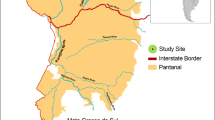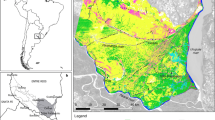Abstract
Tramer (1969) proposed that communities regulated by competition in benign, predictable environments were characterized by (i) damped variation in evenness relative to variation in richness over time, and (ii) high evenness relative to communities regulated by variation in the abundance and diversity of resources in rigorous, unpredictable environments. To test whether patterns of variation in diversity could reflect the mechanisms proposed to regulate community structure, temporal and spatial changes in the diversity, richness and evenness of breeding duck communities were examined along a gradient of variability in wetland conditions using thirty-three years of duck census and climate data from the Canadian prairie and boreal forest regions. Temporal variation in evenness was independent of wetland habitat variability. Changes in richness were more parsimoniously explained by the appearance of ducks displaced (by drought) from rigorous, variable, wetland habitats into relatively benign ones, than by competition in benign areas. Evenness was not significantly higher for duck guilds in more constant wetland habitats, as predicted. Variation in richness, evenness and diversity, predicted by Tramer, do not provide a basis for distinguishing the factors that regulate duck community structure.
Similar content being viewed by others
References
Adams GD (1988) Wetlands of the prairies of Canada. In: National Wetlands Working Group (eds) Wetlands of Canada. Ecological Land Classification Series, No. 24. Sustainable Development Branch, Environment Canada, Ottawa, Ontario, and Polyscience Publications Inc. Montreal, Quebec pp 155–198
Anonymous (1977) Standard operating procedures for aerial waterfowl breeding ground population and habitat surveys. US Fish Wildl Serv, Off Migr Bird Manage
Anonymous (1978) Hydrological Atlas of Canada. Fish and Env Can, Surv Map Branch, Dept EMR
Anonymous (1986) The National Atlas of Canada-Distribution of Wetlands. Surv Map Branch, Dept EMR
Atchley WR, Gaskins CT, Anderson D (1976) Statistical properties of ratios. I. Empirical results. Syst Zool 25:137–148
Austin GT, Tomoff CS (1978) Relative abundance in bird populations. Am Natur 112:695–699
Bellrose FC (1980) Ducks, geese and swans of North America-Second Edition. Harrisburg, Stackpole Books, Pennsylvania, USA
Benning DS (1976) Standard procedures for waterfowl populations and habitat surveys. US Fish Wildl Serv, Operating Manual
Bowden DC (1973) Review and evaluation of May waterfowl breeding ground survey. Unpublished Report to US Fish Wildl Serv, Patuxent, Laurel, Md
Boyd H (1981) Prairie dabbling ducks 1941–1990. Can Wildl Serv Progress Note 119
Caughley G (1977) Anlysis of vertebrate populations. John Wiley and Sons, London
Connell JH (1978) Diversity in tropical rain forests and coral reefs. Science 199:1302–1310
Crissey WF (1969) Prairie potholes from a continental viewpoint. Saskatoon Wetlands Seminar, Can Wildl Ser Rep Ser No 6:161–171
Dannell K, Sjöberg K (1982) Seasonal and diel changes in the feeding behaviour of some dabbling duck species on a breeding lake in northern Sweden. Ornis Scand 13:129–134
Giller PS, Gee JHR (1987) The analysis of community organization: the influence of equilibrium, scale and terminology. In: Gee JHR, Giller PS (eds) Organization of communities-past and present. Blackwell Scientific Publications, Oxford, pp 519–542
Grant PR (1986) Interspecific competition in fluctuating environments. In: Diamond J, Case TJ (eds) Community ecology. Harper & Row, New York, pp 173–191
Hansen HA, McKnight DE (1964) Emigration of drought-displaced ducks to the Arctic. Trans North Am Wildl Nat Resour Conf 29:119–126
Hill MO (1973) Diversity and evenness: a unifying notation and its consequences. Ecology 54:427–432
Johnson DH, Grier JW (1988) Determinants of breeding distributions of ducks. Wildl Monogr No 100
Kaminski RM, Prince HH (1981) Dabbling duck and aquatic macroinvertebrate responses to manipulated wetland habitat. J Wildl Manage 45:1–15
Kantrund HA, Stewart RE (1977) Use of natural basin wetlands by breeding waterfowl in North Dakota. J Wildl Manage 41:243–253
Kricher JC (1972) Bird species diversity: the effect of species richness and equitability on the diversity index. Ecology 53:278–282
Kricher JC (1975) Diversity in two wintering bird communities: possible weather effects. Auk 92:766–777
Kushlan JA (1976) Environmental stability and fish community diversity. Ecology 57:821–825
Martin FW, Pospahala RS, Nichols JD (1979) Assessment and population management of North American migratory birds. In: Cairns Jr J, Patil GP, Waters WE (eds) Environmental biomonitoring, assessment, prediction and management-Certain case studies and related quantitative issues. International Cooperative Publishing House, Fairland, Md, pp 187–239
Meents JK, Rice J, Anderson BW, Ohmart RD (1983) Nonlinear relationships between birds and vegetation. Ecology 64:1022–1027
Millar JB (1982) Classification of wetlands on air/ground comparison transects in the prairie provinces. Part I. Waterfowl strata 30 to 33. Can Wildl Ser Proj Rep, Saskatoon, Saskatchewan
Millar JB (1983) Classification of wetlands on air/ground comparison transects in the prairie provinces. Part II. Waterfowl strata 34 to 40. Can Wildl Ser Proj Rep, Saskatoon, Saskatchewan
Millar JB (1984) Classification of wetlands on air/ground comparison transects in the prairie provinces. Part III. Waterfowl strata 26 to 29. Can Wildl Ser Proj Rep, Saskatoon, Saskatchewan
Murkin HR, Kaminski RM, Titman RD (1982) Responses by dabbling ducks and aquatic invertebrates to an experimentally manipulated cattail marsh. Can J Zool 60:2324–2332
Nudds TD (1983a) Variation in richness, evenness, and diversity in diving and dabbling ducks guilds in prairie pothole habitats. Can J Zool 61:1547–1550
Nudds TD (1983b) Niche dynamics and organization of waterfowl guilds in variable environments. Ecology 64: 319–330
Nudds TD (1992) Patterns in breeding waterfowl communities. In: Batt BDJ, et al. (eds) The ecology and management of breeding waterfowl. University of Minnesota Press, Minneapolis, Minnesota, pp 540–567
Patterson JH (1976) The role of environmental heterogeneity in the regulation of duck populations. J Wildl Manage 40:22–32
Pianka ER (1966) Latitudinal gradients in species diversity: a review of concepts. Am Nat 100:33–46
Pianka ER (1967) On lizard species diversity: North American flatland deserts. Ecology 48:333–351
Pospahala RS, Anderson DR, Henny CJ (1974) Population ecology of the mallard: II. Breeding habitat conditions, size of breeding populations, and production indices. US Fish Wildl Serv Resour Publ 115
Pöysä H (1984) Species assembly in the dabbling duck (Anas spp.) guild in Finland. Ann Zool Fenn 21:451–464
Rotenberry JT (1978) Components of avian diversity along a multifactorial gradient. Ecology 59:693–699
Rotenberry JT, Fitzner RE, Rickard WH (1979) Seasonal variation in avian community structure: differences in mechanisms regulating diversity. Auk 96:499–505
SAS Institute (1985) SAS/STAT guide for personal computers, Version 6 Edition. SAS Institute Inc., Cary, NC, USA
Sheehan PJ, Baril A., Mineau P, Smith DK, Harfenist A, Marshall WK (1987) The impact of pesticides on the ecology of prairie nesting ducks. Can Wildl Ser Technical Report Series No 19
Shmida A, Wilson MW (1985) Biological determinants of species diversity. J Biogeogr 12:1–20
Smith AG (1971) Ecological factors affecting waterfowl production in the Alberta parklands. United States Bureau of Sport Fischeries and Wildlife Resource Publication 98
Smith KG, MacMahon JA (1981) Bird communities along a montane sere: community structure and energetics. Auk 98:8–28
Snedecor GW, Cochran WG (1980) Statistical methods. Iowa State University Press, Ames, Iowa
Stoudt JII (1971) Ecological factors affecting waterfowl production in the Saskatchewan parklands. United States Bureau of Sport Fischeries and Wildlife Resource Publication 98
Strong Jr DR, Simberloff D, Abele LG, Thistle AB (1984) Ecological communities: conceptual issues and the evidence. Princeton University Press, Princeton, New Jersey
Tabachnick BG, Fidell LS (1983) Using Multivariate Statistics. Harper & Row, New York
Tramer EJ (1969) Bird species diversity: components of Shannon's formula. Ecology 50:927–929
Uetz GW (1975) Temporal and spatial variation in species diversity of wandering spiders (Araneae) in deciduous forest litter. Environ Ent 4:719–724
Wiens JA (1977) On competition in variable environments. Am Sci 65:590–597
Wiens JA (1984) On understanding a non-equilibrium world: myth and reality in community patterns and processes. In: Strong Jr DR, Simberloff D, Abele LG, Thistle AB (eds) Ecological communities: conceptual issues and the evidence. Princeton University Press, Princeton, New Jersey, pp 439–457
Wiens JA (1986) Spatial scale and temporal variation in studies of shrubsteppe birds. In: Diamond J, Case TJ (eds) Community ecology. Harper & Row, New York, pp 154–172
Wiens JA (1989) The ecology of bird communities-Vol 1: Foundations and patterns. Cambridge University Press, New York
Wiens JA, Rotenberry JT, Van Horne B (1987) Habitat occupancy patterns of North American shrubsteppe birds: the effects of spatial scale. Oikos 48:132–147
Williams GDV, Robertson GW (1965) Estimating most probable prairie wheat production from precipitation data. Can J Plant Sci 45:34–47
Author information
Authors and Affiliations
Rights and permissions
About this article
Cite this article
Bethke, R.W., Nudds, T.D. Variation in the diversity of ducks along a gradient of environmental variability. Oecologia 93, 242–250 (1993). https://doi.org/10.1007/BF00317677
Received:
Accepted:
Issue Date:
DOI: https://doi.org/10.1007/BF00317677




